INTRODUCTIONIn the aged one, the auditory loss, is one of the three more prevalent chronic conditions, being behind only of the arthritis and the hypertension (1,2). According to (3), approximately 90% of the people with superior age the 80 years present auditory loss.
When it occurs in function of the aging process it is known as presbycusis and it generates one of the crippling riots of the communication, hindering the aged ones to play in the society, because it not only provokes the sensorial privation to hear, as the difficulty of understanding of speaks of that they surround it making it difficult the full communication (1,4,5,6). Besides, it causes a series of social problems, amongst them: the removal of the social and familiar activities, low self-worth, isolation, solitude, depression and irritability (1,7,8). The aging process does not only represent the loss of the auditory threshold, it generates structural and functional modifications compromising all the components of the postural, sensorial control (visual, somatic sensorial and vestibular contest), effector (force, amplitude of movement, biomechanical alignment, flexibility) and the central processing (9,10).
The physiological reduction of the vision, the hearing, the corporal stability, the articulate alterations and of the muscular power can facilitate to the risks of accidents and fall for the slowing of the defensive reactions (11).
The falls are dealt with as factor great epidemiologist relevance, social and economic in the whole world, therefore, it is the type most common of accident between the aged ones (12). The complications lead the causes of deaths in people above of 65 years and promote physical, psychological, and social deficiency, being able to take the individual the dependence, reduction of the daily activities and the confidence, alteration of the life style (13) generating negative consequences in relation to the quality of life (14).
As the life expectancy is increasing, it is important to adopt measured in which they minimize the damages caused for it a time that the surgical and medicinal indications are rare, taking advantage the use of adaptations of device of individual sonorous amplification (AASI). The use allows the rescue of the perception of the sounds of speaks, beyond the ambient sounds, promoting the improvement of the communication ability (15).
The increase of the social visibility of the segment of people older than 60 years, in Brazil, was one of the factors that had instigated the mobilization of governmental bodies and not governmental for the attendance of the new demands appeared in the scope of the health, the assistance and the social security (16). In 2004 the Health department, instituted the National Politics of Attention to the Auditory Health and through nº would carry SAS/MS. 587 had distribution of the state net for action in the basic attention, the average and high complexity (BRAZIL, Health department, 2004). By means of deliberation CIB-SUS-MG nº 156 in 21/03/2005, the Association of Parents and Friends of Exceptional (APAE) of Patos de Minas was credential and qualified to the rendering of services of the related program having guaranteed to the individual the diagnosis, adaptation and supply of the device of individual sonorous amplification - AASI (17).
In this context, the objective of this study was to evaluate balance, fear of fall and aged quality of life of with bilateral sensorineural auditory loss before and after the adaptation to the device of individual sonorous amplification (AASI).
METHODThis study was previously approved by the Committee of Ethics and Research with human beings of the UNITRI (register nº 647923) and followed resolution 196/96 of the National Advice of Health. All the procedures had been explained as well as described at great length in the assent term, that was signed by the volunteers, and from now on, it was initiated collects it of data.
The sample was constituted by 56 individuals (32 of the masculine sex) between 60 and 84 years, carriers of bilateral sensorineural auditory loss, chosen teams from handbooks of the Service of Attention to Hearing Care (SASA).
The handbooks had been constituted by evaluation of the otoloraryngologist, audiological evaluation, speech therapy evaluation, interview with social assistant and psychologist. All the volunteers had putted prosthesis with hearing devices.
The aged inserted carriers of bilateral sensorineural loss auditory in the System of Attention to Hearing Care (SASA) had been enclosed of Patos de Minas/MG - Brazil, with age between 60 and 84 years; e excluded the users of prosthesis or orthesis of inferior members; carriers of neurological and behavioral riots; individuals previously submitted to the auditory rehab; not signature of the Term of Free and Clarified Assent; not understanding of the commands for the application of the tests.
In the evaluation the identification data had been collected, physicians, anthropometrics (weight, height and index of corporal mass - IMC).
The volunteers had answered to the questionnaires of quality of life (questionnaire SF-36) (18) and of fear to fall (Falls Efficacy Scale - International /FES-I) (19) and had carried through the balance test (Berg Balance Scale/BBS) (20). After 4 months, the volunteers who have adapted to the AASI, had returned for reevaluation, they had remade the balance test, and had answered beyond the questionnaires cited to the Satisfaction with Amplification in Daily Life (SADL) (21). All the questionnaires applied in this research previously had been validated and possess adequate psychometrics properties.
Statistical Analysis
The prevalence of the variable: sex, degree of auditory loss, presence of humming, presence of vertigo, the sample had been dichotomized and analyzed for the test of the independence Qui-square.
For comparative analysis of you prop up them of the domains of the SF-36 was used the test of Mann Whitney. Test T was used to compare the anthropometrics data and age of the sample.
The values of FES-I, BERG and BBS between the adapted, not-adapted groups and reevaluated had been compared by means of the Analysis of the Variance (ANOVA Two Way) and the test of Post-hoc de Tukey.
To correlate the follow up of the domains of the SF-36, scale BBS, to the FES-I, the presence of vertigo, the presence of humming and to the age of the volunteers the Correlation of Spearman was used.
A level of significance of 5% (p< 0,05) in all was considered on the tests.
RESULTSIt is noticed in Table 1, a homogeneous distribution between the gender and how much to the degree of auditory loss and one high prevalence of humming and vertigo between the participants.
Table 2 presents the anthropometrics characteristics, age and props up of scales FES-I and BBS of the volunteers. One verifies overweight in the sample, good level of balance and little fear to fall.
We observe that volunteers present good shore up in domains of SF-36, what indicates that does not have reduction in the quality of life in aged with auditory loss, however is distinguished reduction of the item vitality (Table 3).
After 4 months of the rank of the auditory device the volunteers who adapted itself to the auditory device had been reevaluated. In our study, 50% of the volunteers adapted to the auditory device. In Table 4, it is noted a homogeneous distribution of the anthropometrics variable and age between the groups.
How much to the adaptation to the AASI, it is noticed that the masculine sex had greater difficulty in adapting to the auditory device and that the degree of auditory loss, complaints of humming and vertigo, are variable that had not influenced in the adaptation of the AASI (Table 5).
As pointed in Table 6, in relation the humming complaint, only 4 of the 20 volunteers had not related benefits with the use of auditory prosthesis in this variable. How much to questionnaire SADL, in the referring item self-confidence, 100% of the volunteers had told to improvement of this variable after adaptation, being that 90% had answered much improvement of the self-confidence.
In Table 7 it is observed that the aged ones that if they did not adapt they present greater functional capacity that the aged ones of the suitable group. However, in the reevaluation of the suitable group (FROG), a significant improvement when comparing with the evaluation was verified. Furthermore, it had significant improvement of the EGS of the suitable group when comparing the values of the evaluation and reevaluation.
In the analysis intergroup, did not have difference between props up them of the BBS and of the FES-I, however, in the analysis intra-group, the suitable group presented minor fear to fall (Table 8).
Table 9 presents the gotten correlations of the groups evaluated between the domains of the SF-36 and you prop up them of scales FES-I, BBS, presence of vertigo, presence of humming and the age. It is verified that in the suitable group it had positive correlation between the BBS and the domains CF, PAIN, EGS and a negative correlation between the FES-I and the domains CF and PAIN.
After the adaptation of the AASI, notices positive correlation between the BBS and domains CF and EGS, as well as, between age AE and. A negative correlation between fear of fall is noticed and domains CF, EGS and VIT.
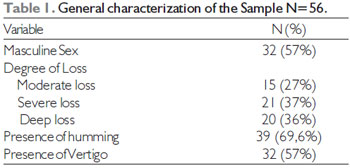
Absolute value (percentile value).

The data are presented on average and shunting line standard.
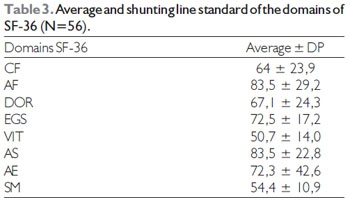
The data are presented on average and shunting line standard.
CF, Functional Capacity; AF, Physical Aspect; EGS, General State of Health; VIT, Vitality; AS, Social Aspects; AE, Emotional Aspects; SM, Mental Health.
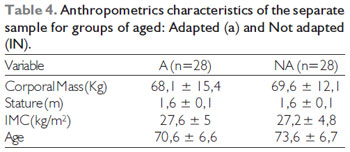
The data are presented on average and shunting line standard.
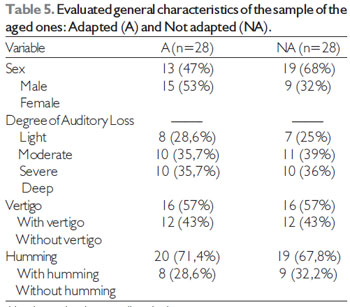
Absolute value (percentile value).
In the present study it had for purpose to evaluate the contribution of auditory device AASI in the quality of life, balance and fear to fall in aged with bilateral sensorineural auditory loss.
To observe greater prevalence of auditory loss in men (57%) corroborating with other studies (7-8). The complaint of humming (69.6%) and vertigo (57%) associate to the auditory loss was highly prevalent in the sample a time that inherent degenerative processes to the age are responsible for the occurrence of vertigo and humming in the geriatric population (10).
The score of the questionnaire that evaluates balance was 51 points, what it represents a good functional balance, probably for the fact of that our sample was constituted by aged not institutionalized with auditory loss and good functional capacity, a time that had been excluded individuals that made use of device of aid to the march and that they presented neurological illnesses.
How much to the fear of fall one was observed score average of 25,5 in the volunteers of this research. Similar results had been found by (22) that when evaluating physically active the aged FES-I of aged of the community and found one medium score of 24,9 and 27,5 respectively. In such a way we can infer that, the auditory loss did not influence in the fear of fall. Probably, this is related to the good balance that the aged ones had presented what it diminishes the fear of fall.
In general, the averages of the scores of the domains of the SF-36 had been above of 50% demonstrating that the volunteers have good quality of life. Second (23) in the SF-36 one props up high in the domain physical aspect and functional capacity can indicate that the aged ones possess little limitation to the work and in activities of daily life, presents good health and functional ability.
We know that the concept of quality of life (QV) is very ample, subjective, dependent of the socio-cultural level, the personal ambitions of the individuals and not only of the structure attack (24). This can be observed in the present study, therefore, nor always a structure attack, as the auditory loss intervenes directly with the quality of life of the volunteers, being the QV a product of some factors.
All the volunteers of the sample had putted prosthesis. After 4 months of use of AASI, 50% of the volunteers adapted to the auditory device. In the suitable volunteers it had reevaluation of the variable: quality of life, balance and fear of fall. This stated period was established in virtue of studies to demonstrate that 90 days are enough for a good adaptation and acclimatization of the AASI (25). How much to the factors related to the adaptation to the AASI, our findings are in accordance with study previously carried through that demonstrated that presence of humming and vertigo do not influence in the adaptation to the AASI (26). However, valley to point out that, previous studies demonstrate that factors as story of satisfaction with the device, the number of hours/day, participation of the family (5), expectations, necessities of communication, degree of loss, tolerance for intense sounds, expectations, motivation (4) and auditory whitewashing (2), is important criteria for a successful adaptation.
One of the main complaints of the aged ones with presbycusis is the presence of the humming that frequent is a factor of great negative repercussion in the life of the individual, compromising the quality of life, making it difficult sleep, the concentration in the daily and professional activities, as well as the social life (27). The humming is an extremely frequent clutter in patients with auditory loss, reaching about 40 million people in U.S.A., affecting approximately 1/3 of the population above of the 65 years of age (28). The practical clinic has demonstrated that carrying individuals of auditory loss associated the humming benefit themselves with the use of auditory prosthesis, therefore these, beyond improving the understanding of the conversation, alleviates the humming, (29), had demonstrated that the use of prosthesis auditory improved the humming in 78,2% of the individuals and our sample 79% of the suitable volunteers if they had benefited with reduction of the humming.
In accordance with (6) the auditory use of prosthesis benefits to the daily activities and the functionality in carrying individuals of sensorineural auditory loss. This corroborates with our findings, therefore we find significant improvement of the functional capacity (CF) and of the general state of health (EGS). Probably due to adaptation to the AASI, improvement of the hearing, the ability of communication occurred and security feeling, which had also influenced the increase of EGS and CF, and consequently improves of the quality of life (7).
Having as endorsement the findings of (30) we believe that the increase of the EGS resulted consequently in the increase in the daily activities of life and of the CF what it reflected in reduction of the fear of fall of the volunteers. Another factor associated with this reduction was possibly the increase of the confidence and security told by the volunteers from the positive results of questionnaire SADL.

Absolute value (percentile value).
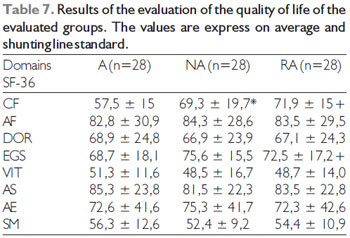
CF, Functional Capacity; AF, Physical Aspect; EGS, General State of Health; VIT, Vitality; AS, Social Aspects; AE, Emotional Aspects; SM, Mental Health.
A, Suitable Group; IN, the Group Not Adapted; FROG, Reevaluation of the Adapted ones.
*p<0,05 comparing the X IN
+p < 0,05 comparing the X FROG

A, , Suitable Group; IN, the Group Not Adapted; FROG Reevaluation of the Adapted ones.
*p < 0,05 comparing the X IN
+p < 0,05 comparing X R
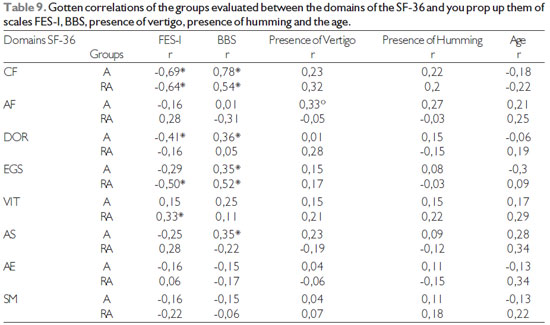
CF, Functional Capacity; AF, Physical Aspects; EGS, General State of Health; VIT, Vitality; AS, Social Aspects; AE, Emotional Aspects; SM, Mental Health; , Suitable Group; IN, the Group not adapted, FROG, Reevaluation of the adapted ones. *p<0,005; +p<0,06; ºp<0,0
Aged with auditory sensorineural loss they had presented good quality of life and balance and had related little concern in falling. However after adaptation to the AASI, had improvement of the quality of life (EGS and CF), reduction of the fear of fall and the humming and increase of the auto-confidence after adaptation to the AASI. Valley to point out despite 50% of the volunteers if only adapted and that the masculine sex had greater difficulty in adapting to the auditory device and that the variable age, degree of loss, presence of humming and vertigo, they had not been factors that had intervened with the adaptation to the AASI.
From this study we can infer that so important the AASI is for the aged one, how much the direct benefit of it in the physiotherapist intervention is. The well adapted patient will have greater communication capacity, increase of the self-confident, greater attention and understanding of the information that are important factors in a preventive and rehabilitative interaction. Valley to point out that the development of new studies that they aim at to elucidate the factors associates to the adhesion to the AASI would be of great interest therefore would prevent unnecessary expenses of the public health.
BIBLIOGRAPHIC REFERENCES1. Bess FH, Hedley-Williams A, Lichtenstein MJ. Avaliação Audiológica em idosos. In: Musiek FE; Rintelmann MJ. Perspectivas atuais em Avaliação Auditiva. São Paulo: Manole; 2001. p.343-369.
2. Miranda EC, Andrade AN, Gil D, Iório MCM. A efetividade do treinamento auditivo formal em idosos usuários e próteses auditivas no período e aclimatização. Rev Soc Bras Fonoaudiol. 2007, 12(4):316-21.
3. Wisconsin Self Help for Hard of Hearing People. 2002. Hearing Loss Statistics. [Acessado 18 de dez 2007] www.wi-shhh.org/hearing_loss_statistics.htm_.
4. Batista ACM, Sampaio FM. Nível de Satisfação dos Idosos usuários de próteses auditivas doadas pela APAC_NAMI_UNIFOR. Rev Bras em Promoção da Saúde. 2005,18:7-10.
5. Miranda EC, Calais LL, Vieira EP, Carvalho LMMA, Borges CLC, Iório MCM. Dificuldades e benefícios com o uso de prótese auditiva: percepção do idoso e sua família. Rev Soc Bras Fonoaudiol. 2008, 13(2):166-72.
6. Silman S, Iório MCM, MizhahI MM, Parra VM. Próteses auditivas: um estudo sobre seu benefício na qualidade de vida de indivíduos portadores de perda auditiva neurossensorial. Distúrbios da Comunicação. 2004, 16(2):153-165.
7. Fausti SA, WIlmington D, Helt PV, Helt, WJ, Konrad-Martin D. Hearing health and care: The need for improved hearing loss prevention and hearing conservation practices - Journal of Rehabilitation Research & Development. 2005, 42(4):45-62.
8. Teixeira AR, Thedy RB, Jotz G. Barba MC. Sintomatologia depressiva em deficientes auditivos adultos e idosos: importância do uso de próteses auditivas. Arq Int Otorinolaringol. 2007, 11:453-458.
9. Chandler JM. Equilíbrio e quedas no idoso: questões sobre a avaliação e o tratamento. In: Guccione AA. Fisioterapia Geriátrica. 2.ed. Rio de Janeiro: Guanabara Koogan; 2002. p.265-77.
10. Ruwer SL, Rossi AG, Simon LF. Equilíbrio no idoso. Rev Bras Otorrinolaringol. 2005, 71(3):298-303.
11. Pereira AMM. A queda e suas conseqüências para o idoso: Aspectos psicológicos e emocionais. [Dissertação]. Uberlândia: Universidade Federal de Uberlândia; 2006.
12. Rebelatto JR, Castro AP, Sako FK, Aurichio TR. Equilíbrio estático e dinâmico em indivíduos senescentes e o índice de massa corporal. Fisioterar Mov. 2008, 21(3):69-75.
13. Maciel ACC, Guerra RO. Fatores associados à alteração da mobilidade em idosos residentes na comunidade. Revista Brasileira de Fisioterapia 2005, 9(1):17-23.
14. Ribeiro AP, Souza ER, Atie S, Souza AC, Schilithz AO. Influência das quedas na qualidade de vida de idosos Ciência & Saúde Coletiva. 2008, 13(4):1265-1273.
15. Magni C, Freilberger F, Tonn K. Avaliação do grau de satisfação entre os usuários de amplificação de tecnologia analógica e digital. Rev Bras Otorrinolaring. 2005; 71(5): 650-657.
16. Rodrigues NC, Rauth J. Os Desafios do Envelhecimento no Brasil In: Freitas et al. Tratado de Geriatria e Gerontologia, Rio de Janeiro: Guanabara Koogan; 2002. p.187-192.
17. Brasil. Ministério da Saúde. In Deliberação CIB-SUS-MG N. º156, de 21 de março de 2005. Credencia a Unidade de Serviço de Atenção à Saúde Auditiva, Associação de Pais e Amigos dos Excepcionais - APAE, do município de Patos de Minas. [Acessado em: 04 de abril 2006]. Disponível http://www.saude.mg.gov.br/atos_normativos/deliberacoes/2005/del_ 156pdf
18. Ware JE, Sherbourne CD. The MOS 36 item shortform health survey (SF36): I. conceptual framework and item selection. Med Care. 1992, 30:473-83.
19. Yardley L, Beyer N, Hauer K, Kempen G, Piot-Ziegler C, Todd C. Development and initial validation of the falls efficacy scale-international (FES-I). Age and Ageing. 2005, 34:614-9.
20. Berg KO, MAKI BE, Willians JI, Holliday PJ, Wood-Dauphinee SL. Clinical and laboratory measures of postural balance in an elderly population. Arch Phys Med Rehabil. 1992, 73:1073-1080.
21. Cox RM, Alexander GC. Measuring satisfaction with amplification in daily life: The SADL scale. Ear Hear 1999; 20(4):306-20.
22. Narciso FV. Avaliação do equilíbrio e da altura percentual do centro de gravidade de idosos. [Dissertação]. Uberlândia: Mestrado em Fisioterapia do Centro Universitário do Triângulo; 2008.
23. Santos LS. Influencia da atividade física na qualidade de vida e no escore de ansiedade e depressão em idosos não-institucionalizados. [Dissertação]. Uberlândia: Mestrado em Fisioterapia do Centro Universitário do Triângulo; 2008.
24. Vecchia RD, Ruiz T, Bocchi SCM, Corrente JE. Qualidade de vida na terceira idade: um conceito subjetivo. Rev Bra Epidemiol. 2005, 89(3):246-52.
25. Prates LPCS, Iório MCM. Aclimatização: estudo do reconhecimento de fala em usuários de próteses auditivas. Barueri, Pró-Fono R Atual Cient. 2006, 18(3)259-66.
26. Mulrow C D, Tuley MR, Aguilar C. Correlates successful hearing aid use in olders adults. Ear and Hearing. 1992, 13(2):108-113.
27. Silva RCF, Bandini, HHM, Soares IA. Aparelho de amplificação sonora individual: melhora a sensação de zumbido? Rev CEFAC. 2007, 9(2):263-68.
28. Lynn SG, Bauch CD, Williams DE, Beatty CW, Mellon W, Weaver AL. Psychologic profile of tinnitus patients using the SCL-90-R and tinnitus handicap inventory. Otol Neurotol 2003, 24(6):878-881.
29. Moura LO, Iório MC, Azevedo MF. A eficácia da adaptação de prótese auditiva na redução ou eliminação do zumbido Rev Bras Otorrinolaringol. 2004, 70(5):624-31.
30. Zijlstra GAR, Haastregt JCM, Eijk MY, Rossum V, Stalenhoef PA, kempen JM. Prevalence and correlates of fear of falling, and associated avoidance of activity in the general population of community-living older people. Age and ageing. 2007, 36:304-309.
1) Master in Physiotherapy. Physiotherapist of the Municipal City Hall of Patos de Minas.
2) Master in Physiotherapy for the University Center of Triangle (UNITRI). Professor.
3) Post-Doctorate for the University of Liverpool, England (1984) Performance in Surgery, with emphasis in Traumatic Surgery Doctor. Professor of the University Centre of Triangulo, Brazil.
4) Doctorate in Physiological Sciences for the Federal University of São Carlos, Brazil (2005). Teacher of the Federal University of Uberlandia/College of Physical Education (FAEFI/UFU). Program of Master in Physiotherapy for the University Center of the Triangle (UNITRI).